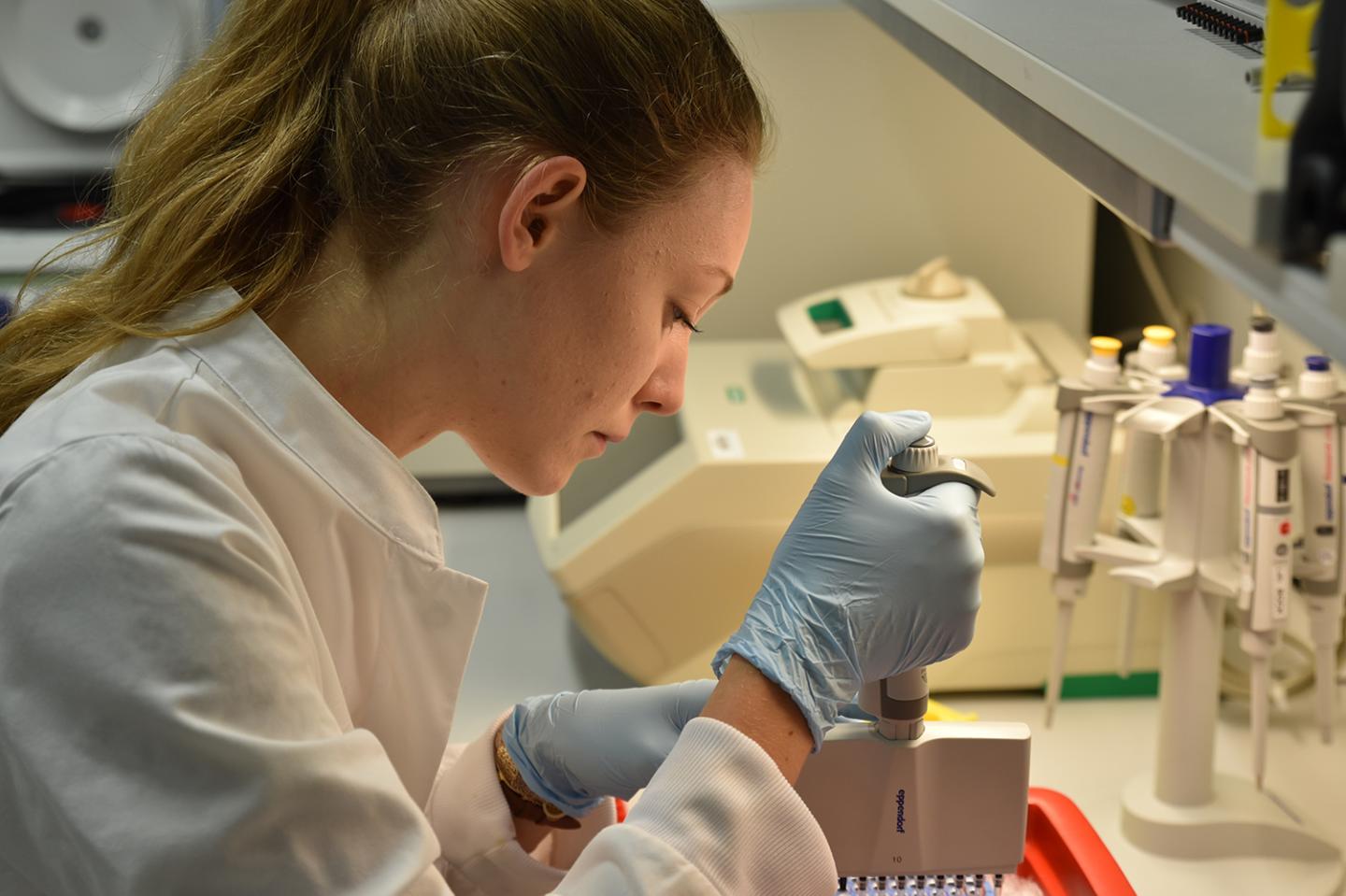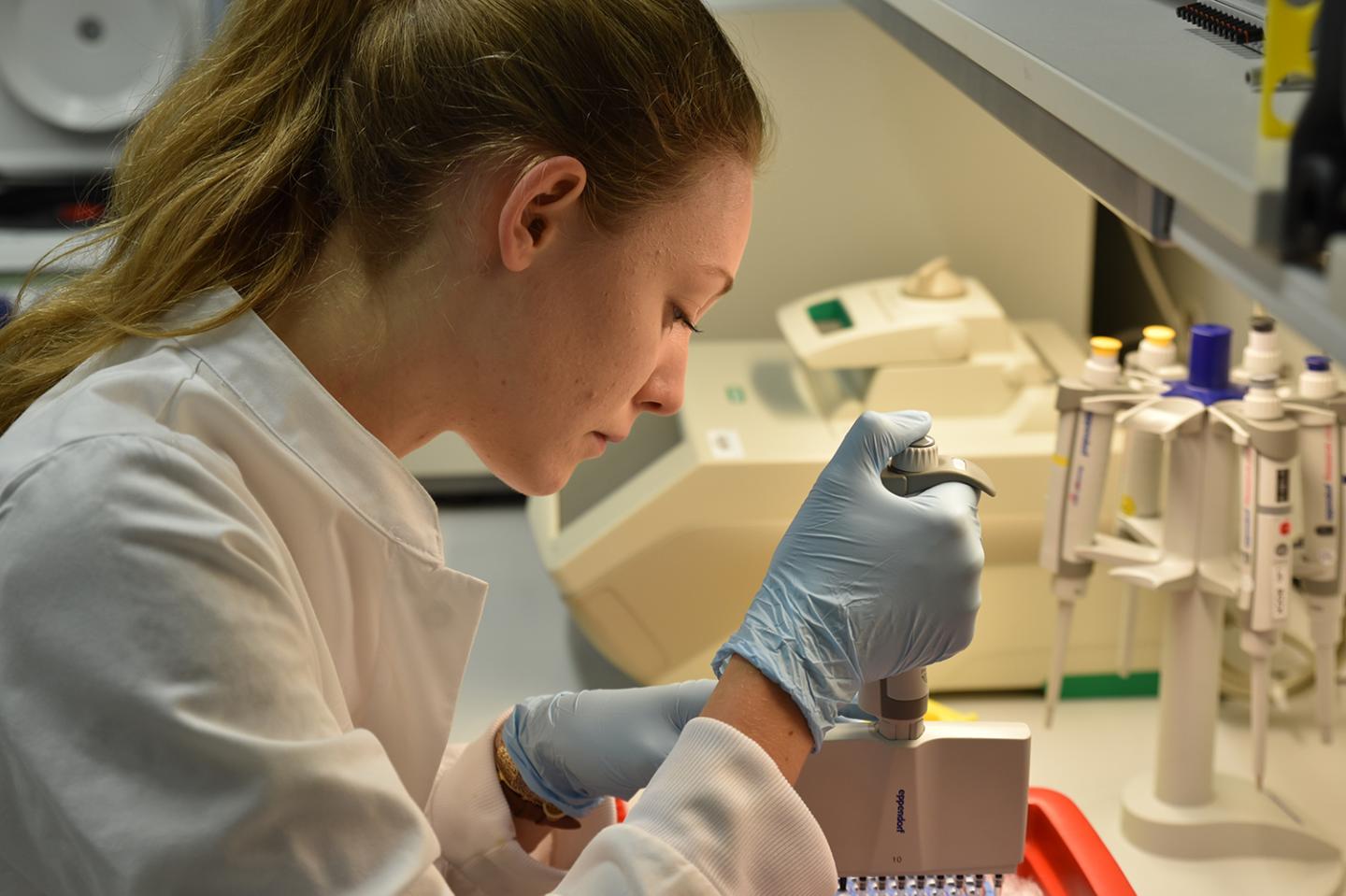
Credit: Wolfgang Däuble / CeMM
(Vienna, 19 January 2017) Genome editing using CRISPR/Cas9 "gene scissors" is a powerful tool for biological discovery and for identifying novel drug targets. In pooled CRISPR screens, a large number of cells are edited simultaneously using CRISPR guide-RNAs against thousands of different genes. Next, some of the edited cells are experimentally selected, and their guide-RNAs are counted to determine which genes are most important for the studied biological mechanism.
This screening method is most useful for addressing questions that are directly linked to a cell's ability to grow, for example identifying genes that protect cancer cells against chemotherapy or immune cells against HIV infection. In contrast, pooled screens are not well suited for studying gene regulation and other complex biological mechanisms. To understand how multiple genes work together to regulate cell state, it is currently necessary to grow, edit, and analyze cells separately for each CRISPR targeted gene, which is tedious and expensive.
In a new article published in Nature Methods (DOI: 10.1038/nmeth.4177), a team of CeMM scientists led by Christoph Bock now present a method that combines the strengths of pooled and arrayed CRISPR screens. By integrating CRISPR genome editing with single-cell RNA sequencing, they were able to determine the gene-regulatory impact of many genes in parallel, studying thousands of individual cells in a single experiment.
Bock's team succeeded with an elegant design that takes advantage of cutting-edge molecular technologies: The study's first author Paul Datlinger created a viral vector for making the CRISPR guide-RNAs visible in single-cell sequencing experiments, and the latest droplet-based methods for single-cell RNA sequencing provided sufficient throughput to characterize the effect of thousands of genome editing events in individual cells.
Creatively combining two of the most promising fields of genomics, the CROP-seq (for "CRISPR droplet sequencing") method enables high-throughput analysis of gene regulation at a scale and detail that would be difficult to achieve with other methods. Furthermore, with falling single-cell sequencing costs, this technology could give rise to the first comprehensive maps of the regulatory effects for each of the 23,000 genes in the human genome.
"We will use CROP-seq to study the interplay of genetic and epigenetic factors in leukemia development", says Christoph Bock, advancing the laboratory's European Research Council (ERC) funded project on epigenome programming. "If we understand what it takes to make a cancer cell in the test tube, we can find new ways to interfere and revert cells to a less harmful state".
CROP-seq was developed as an open source method. All data, protocols, reagents and software that are part of CROP-seq will be freely shared by CeMM, enabling other scientists to use and extend the method in their own work. The ambition to making new methods as widely available as possible is part of CeMM's commitment to advancing biomedical research.
###
Attached pictures: 1.: Microfluidic droplets capture single, genome-edited cells and barcode their transcriptome (© Paul Datlinger/CeMM) 2. Christoph Bock, Principal Investigator at CeMM (© Wolfgang Däuble / CeMM) 3. A scientist in Christoph Bock's lab studying gene regulation (© Wolfgang Däuble / CeMM)
The study "Pooled CRISPR screening with single-cell transcriptome readout" was published in Nature Methods on 18 January 2017. DOI: 10.1038/nmeth.4177
Authors: Paul Datlinger, André F Rendeiro, Christian Schmidl, Thomas Krausgruber, Peter Traxler, Johanna Klughammer, Linda C Schuster, Amelie Kuchler, Donat Alpar, Christoph Bock
Funding: The study was partly funded by a New Frontiers Group award of the Austrian Academy of Sciences and by an ERC Starting Grant.
Christoph Bock is a Principal Investigator at CeMM. Trained as a bioinformatician, he leads a team that integrates biology, medicine, and computer science – working on a vision of precision medicine that is driven by large datasets and a deep understanding of biological disease mechanisms. He is also a guest professor at the Medical University of Vienna's Department for Laboratory Medicine, and he coordinates the genome sequencing activities of CeMM and the Medical University of Vienna. At CeMM, he co-initiated and leads Genom Austria, the Austrian contribution to the International Network of Personal Genome Projects, and he is a principal investigator in the BLUEPRINT project and the International Human Epigenome Consortium. http://epigenomics.cemm.oeaw.ac.at/
The mission of CeMM Research Center for Molecular Medicine of the Austrian Academy of Sciences is to achieve maximum scientific innovation in molecular medicine to improve healthcare. At CeMM, an international and creative team of scientists and medical doctors pursues free-minded basic life science research in a large and vibrant hospital environment of outstanding medical tradition and practice. CeMM's research is based on post-genomic technologies and focuses on societally important diseases, such as immune disorders and infections, cancer and metabolic disorders. CeMM operates in a unique mode of super-cooperation, connecting biology with medicine, experiments with computation, discovery with translation, and science with society and the arts. The goal of CeMM is to pioneer the science that nurtures the precise, personalized, predictive and preventive medicine of the future. CeMM trains a modern blend of biomedical scientists and is located at the campus of the General Hospital and the Medical University of Vienna. http://www.cemm.at
For further information please contact:
Mag. Wolfgang Däuble
Media Relations Manager
CeMM
Research Center for Molecular Medicine of the Austrian Academy of Sciences
Lazarettgasse 14, AKH BT 25.3
1090 Vienna, Austria
Phone +43-1/40160-70 057
Fax +43-1/40160-970 000
[email protected]
http://www.cemm.at
Media Contact
Wolfgang Däuble
[email protected]
43-140-160-70057
@CeMM_News
http://www.cemm.oeaw.ac.at
############
Story Source: Materials provided by Scienmag





